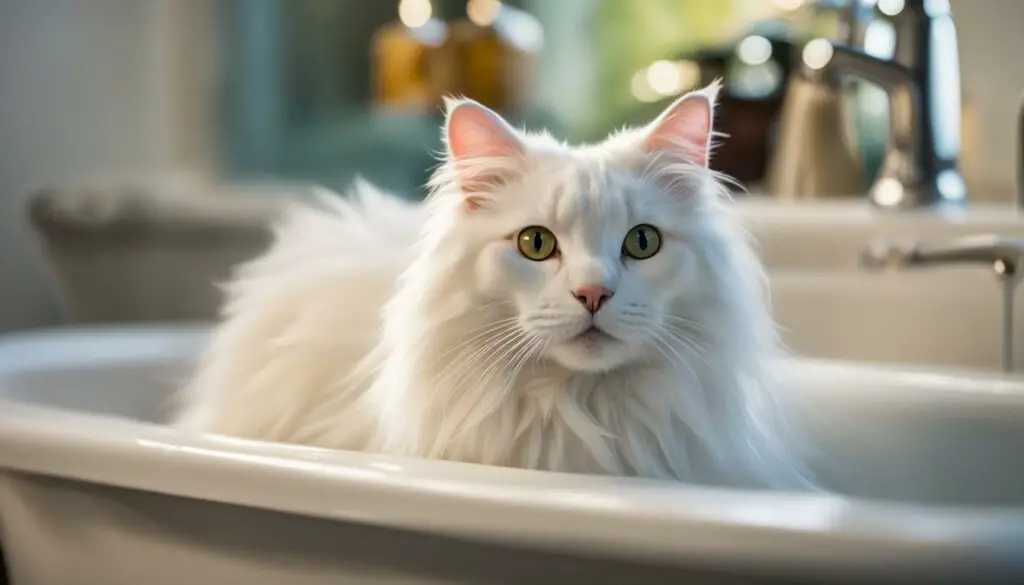As a cat owner, you may have wondered if it’s safe to use human shampoo on your furry friend. After all, our shampoo works just fine for us, so why not use it on cats too? However, when it comes to cat grooming, it’s important to understand the differences between human and feline needs. In this article, I will explore the facts and provide you with valuable insights on the topic.
Key Takeaways:
- Using human shampoo on cats can disrupt their skin’s pH balance, leading to potential skin issues.
- Some human shampoos may contain ingredients that are toxic to cats if ingested or absorbed through the skin.
- It’s best to use shampoo specifically formulated for cats to maintain their skin health and prevent harm.
- Regular cat hygiene, including proper bathing and grooming, is crucial for their overall well-being.
- Consult with your veterinarian to choose a safe and suitable shampoo for your cat’s specific needs.
The Importance of Cat Hygiene
Maintaining proper hygiene is crucial for cats’ overall health and well-being. Regular bathing helps to keep their coat clean, reduce dandruff, eliminate parasites, and remove dead hair. It also helps control odors and reduces shedding, especially for long-haired cats. Additionally, grooming products designed specifically for cats can help with maintaining hygiene and promoting a healthy coat.
Benefits of Regular Cat Bathing
Regular cat bathing offers several benefits to the overall health and well-being of cats. It helps maintain a healthy coat, reduces dandruff, removes dead hair and parasites, controls odors, and minimizes shedding. Long-haired cats, in particular, can greatly benefit from regular bathing to prevent matting and tangles. Bathing also provides an opportunity for owners to observe any skin issues or abnormalities that may require further attention.
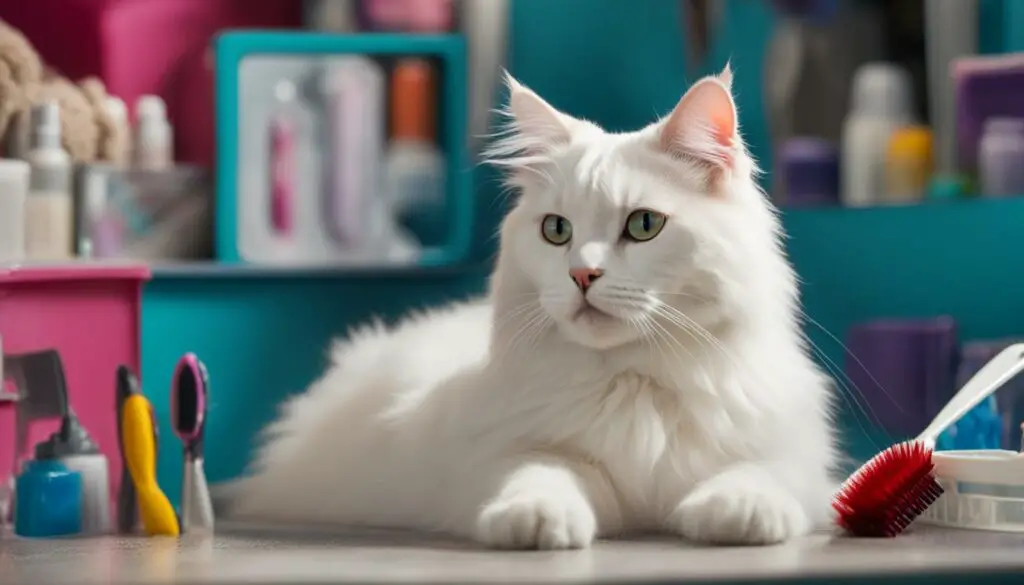
Choosing the Right Cat Grooming Products
When it comes to maintaining cat hygiene, using the right grooming products is essential. Look for shampoos, conditioners, and brushes specifically formulated for cats. These products are designed to be gentle on their skin and coat, reducing the risk of irritation or allergies. Additionally, using grooming tools such as combs and brushes can help remove loose hair and prevent matting, keeping your cat’s coat healthy and tangle-free.
| Grooming Product | Description |
|---|---|
| Cat Shampoo | Mild and gentle formula specifically designed for cats. Helps to clean their coat and maintain skin health. |
| Cat Conditioner | Moisturizes and softens the cat’s coat, making it easier to groom and reducing tangles. |
| Grooming Brush | Removes loose hair, reduces shedding, and prevents matting. Promotes a healthy, shiny coat. |
| Ear Cleaner | Gently cleans and removes ear wax, preventing ear infections and discomfort. |
| Nail Clippers | Helps to keep the cat’s nails trimmed and prevents them from becoming too long or sharp. |
By incorporating regular bathing and using cat-specific grooming products into your cat care routine, you can ensure that your feline friend maintains optimal hygiene and a healthy coat. Remember to consult with your veterinarian for personalized advice and recommendations based on your cat’s specific needs.
Understanding the Risks of Using Human Shampoo
Using human shampoo on cats can have detrimental effects on their skin and overall health. There are significant differences in the pH levels and ingredients between human and cat shampoos, making human shampoo unsuitable for feline use. Cats have a more neutral pH on their skin compared to humans. When you use human shampoo on a cat, it disrupts the natural balance of their skin’s pH, leading to potential skin irritation, dryness, and other skin issues. Furthermore, some ingredients found in human shampoos can be toxic to cats if ingested or absorbed through the skin.
It is crucial to use products specifically made for cats to avoid these risks. Cat shampoos are formulated to maintain the natural pH balance of a cat’s skin and contain ingredients that are safe for them. By choosing a cat-specific shampoo, you ensure that your cat’s skin remains healthy and free from any potential harm. Using cat shampoo also helps maintain the integrity of their skin’s acid mantle, protecting it from external factors that can cause skin problems.
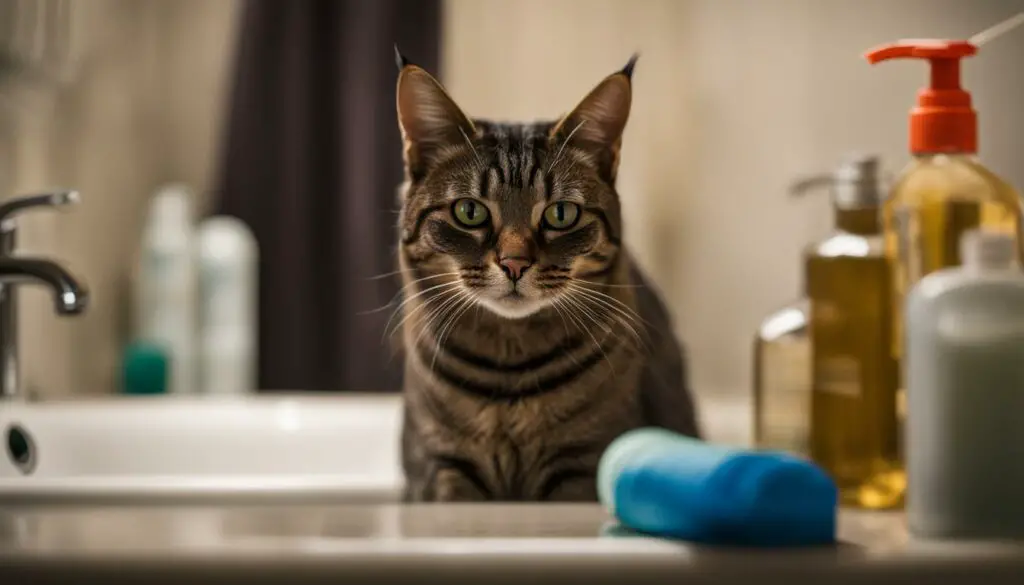
To further illustrate the differences between cat shampoo and human shampoo, here is a comparison table:
| Cat Shampoo | Human Shampoo | |
|---|---|---|
| pH Level | Neutral or slightly acidic | Can vary, often more alkaline |
| Ingredients | Specifically formulated for cats, free from toxic substances | Variety of ingredients, some of which can be harmful to cats |
| Effect on Skin | Maintains the integrity of the skin’s natural balance | Disrupts the natural balance, leading to potential skin issues |
| Convenience | Available in pet stores and online, specifically for cats | Widely available, but not designed for feline use |
It is important to prioritize your cat’s well-being by choosing appropriate grooming products. By understanding the risks of using human shampoo on cats and opting for cat-specific shampoos, you can help maintain your cat’s skin health and overall hygiene.
Choosing a Safe Shampoo for Your Cat
When it comes to keeping your cat clean and healthy, choosing the right shampoo is essential. Using human shampoo on cats can disrupt their skin’s pH balance and potentially expose them to harmful ingredients. To ensure the well-being of your furry friend, it’s important to opt for a safe shampoo specifically formulated for cats.
When selecting a shampoo for your cat, look for products that are mild, hypoallergenic, and free from harsh chemicals or fragrances. These shampoos are designed to maintain the natural pH balance of a cat’s skin, preventing skin irritation and dryness. Additionally, hypoallergenic formulas can help minimize the risk of allergic reactions.
Consulting with your veterinarian can also be helpful in choosing the right shampoo for your cat. They can provide personalized recommendations based on your cat’s specific needs, such as whether they have any existing skin conditions or allergies. Veterinarians can also guide you on how frequently you should bathe your cat and recommend any additional grooming products that may be beneficial.
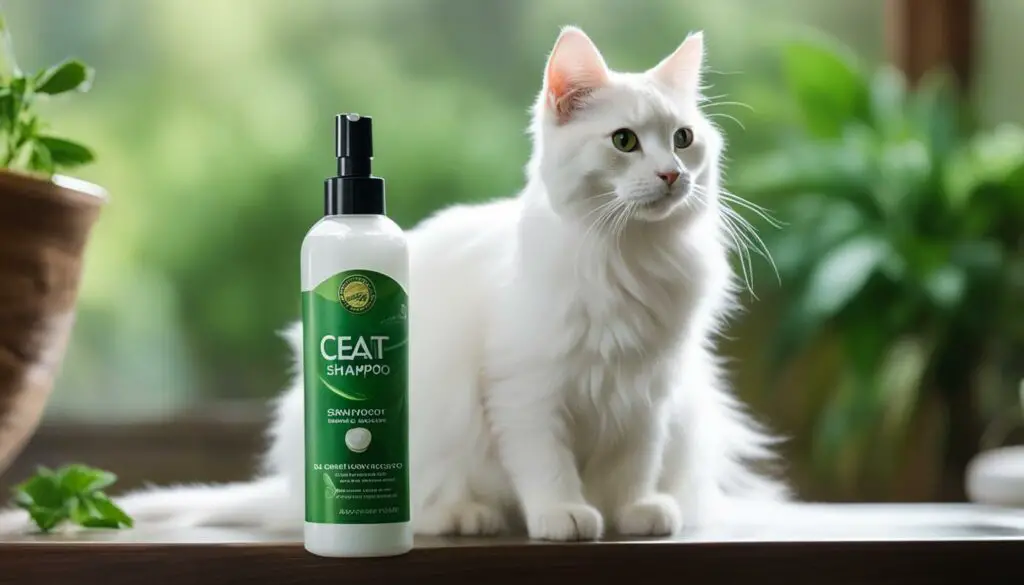
Table: Comparison of Safe Shampoos for Cats
| Product | Key Features | Price |
|---|---|---|
| Brand A | Mild formula, hypoallergenic, natural ingredients | $10 |
| Brand B | Gentle cleansing, moisturizing, suitable for sensitive skin | $12 |
| Brand C | Medicated formula, helps with skin conditions, vet recommended | $15 |
When using cat shampoo, it’s important to follow the instructions provided by the manufacturer. This includes diluting the shampoo with water if necessary, as concentrated formulas can be too harsh for cats’ sensitive skin. It’s also recommended to avoid getting shampoo in your cat’s eyes, ears, and mouth, as these areas can be sensitive.
By choosing a safe shampoo for your cat and following proper bathing techniques, you can help maintain their skin’s health and overall well-being. Regular grooming and bathing with the right products can contribute to a clean and shiny coat, reduce shedding, and keep your furry friend looking and feeling their best.
Proper Preparation for a Cat Bath
Before giving your cat a bath, it’s important to prepare them properly to ensure a smooth and stress-free experience. Just like humans, cats appreciate a calm and organized bathing process. Here are some essential steps to follow:
Gather all necessary grooming products
Make sure you have everything you need within reach before starting the bath. This includes cat shampoo, towels, a non-skid rubber mat or towel for the sink or tub, cotton balls for the ears, and treats for positive reinforcement.
Trim your cat’s nails
Trimming your cat’s nails before the bath will help prevent any accidental scratches. It’s best to use nail clippers specifically designed for cats and be gentle while trimming. If you’re unsure or uncomfortable doing this yourself, consult a professional groomer or your veterinarian.
Brush your cat’s coat
Brushing your cat’s coat before the bath helps remove any dead skin and hair, making the bathing process more effective. It also allows you to spot any mats or tangles that may require extra attention. Use a cat-specific brush or comb suitable for your cat’s coat type.
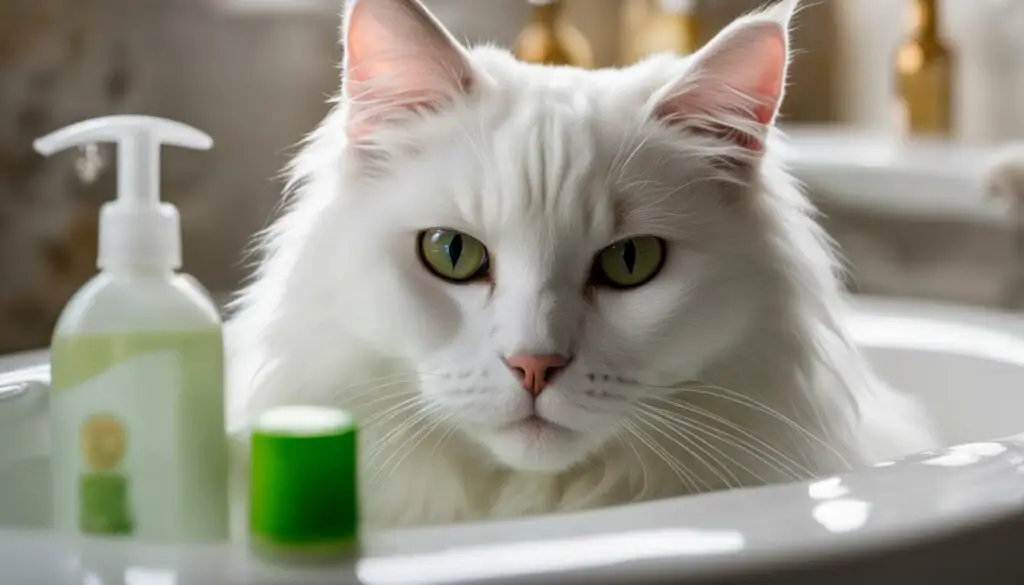
Place cotton balls in their ears
To prevent water from entering your cat’s ears and causing discomfort, gently place cotton balls in their ear canals. Be sure not to push them too far in and make sure they’re secure but not too tight.
Use a non-skid mat or towel
Place a non-skid rubber mat or towel in the sink or tub to provide your cat with stability and prevent slipping. This will help your cat feel more secure during the bathing process.
Keep a calm environment
Ensure the bathing area is quiet and free from distractions that may startle your cat. Closing the bathroom door and minimizing loud noises will help create a calm environment for the bathing process.
Summary:
Proper preparation is key to a successful cat bath. Gather all necessary grooming products, trim your cat’s nails, brush their coat, place cotton balls in their ears, use a non-skid mat, and maintain a calm environment. Following these steps will help ensure a stress-free and enjoyable bathing experience for both you and your cat.
The Bathing Process for Cats
When it comes to bathing cats, it’s important to follow a step-by-step process to ensure their comfort and safety. Here’s a guide on how to give your feline friend a successful bath:
Preparation
Before starting the bath, gather all the necessary supplies. You will need a cat-specific shampoo, towels, a non-skid mat or towel for the tub or sink, and treats for positive reinforcement. Trim your cat’s nails beforehand to avoid scratching and gently brush their coat to remove any loose hair.
Getting Started
Fill the bath with warm (not hot) water and gently lower your cat into it. It’s important to avoid using the shower head as the sound may unsettle your cat. Instead, use a small jug or cup to pour warm water over their body. Begin wetting their fur, starting from the back and working your way towards the head.
Using Cat Shampoo
Dilute the cat shampoo with water (1 part shampoo to 5 parts water) before applying it to your cat’s fur. This helps to minimize the risk of skin irritation. Massage the shampoo into their coat, paying special attention to areas that are prone to getting dirty or oily. If needed, use a wet washcloth to clean their face gently.
Rinsing and Drying
Rinse your cat thoroughly to remove any excess shampoo or conditioner, as cats may lick it off. Make sure to rinse every part of their body, including under the belly and between the toes. Once rinsed, gently towel dry your cat or allow them to air dry in a warm room. Avoid using a blow dryer unless your cat is accustomed to the noise, and always use the lowest setting to prevent overheating.
Remember to offer treats and plenty of praise throughout the bathing process to reward your cat for their cooperation. With patience and a gentle approach, bathing can become a positive experience for both you and your feline companion.

Tips for Calming a Nervous Cat During Bath Time
Bathing a cat can be a stressful experience for both the cat and the owner. Cats are known for their independent nature and can become anxious or fearful when it comes to water. However, with the right approach and some helpful tips, you can help calm your nervous cat during bath time.
Creating a Calm Environment
Before starting the bathing process, it’s important to create a calm and soothing environment for your cat. Find a quiet and comfortable space where you can bathe them without distractions. Play soft music or use a white noise machine to help drown out any loud noises that may startle your cat. Dimming the lights can also create a more relaxing atmosphere.
Additionally, it can be helpful to have a second person present during bath time. This person can provide extra comfort and support by gently holding the cat’s head and speaking softly to them. Having a familiar face nearby can help alleviate some of your cat’s anxiety.

Positive Reinforcement and Treats
Positive reinforcement is key when it comes to calming a nervous cat during bath time. Offer treats as rewards for good behavior and provide lots of praise and affection throughout the process. Create positive associations by giving treats before, during, and after the bath. This can help your cat associate bath time with something enjoyable and rewarding.
It’s important to be patient and understanding with your cat. If they become too stressed or agitated, take a break and try again later. Pushing them into a situation that causes extreme anxiety can have long-lasting effects on their trust and confidence.
Remember, bathing your cat should be a positive experience for both of you. By creating a calm environment, offering treats and positive reinforcement, and being patient and understanding, you can help your nervous cat feel more relaxed during bath time.
The Importance of Drying and Post-Bath Care for Cats
After giving your cat a bath, proper drying and post-bath care are essential for their comfort and overall well-being. Drying them thoroughly helps prevent them from catching a cold and ensures their coat remains clean and healthy. Here are some tips for drying and caring for your cat after a bath:
Towel Drying
When your cat is finished with their bath, gently wrap them in a large towel and pat them dry. Avoid rubbing vigorously, as it can cause discomfort and tangle their fur. Take your time to remove as much moisture as possible, paying attention to difficult-to-reach areas like their belly and paws. Remember to have a few extra towels nearby in case the first one becomes saturated.
Avoid Blow Dryers
While some cats may tolerate the noise and feel of a blow dryer, it’s generally best to avoid using them unless your cat is accustomed to it. If you do choose to use a blow dryer, set it to the lowest heat and speed settings to prevent overheating your cat’s sensitive skin. Always maintain a safe distance between the dryer and your cat, and never leave them unattended during the drying process.
Natural Air Drying
Most cats prefer natural air drying and will groom themselves to further dry their coat. Ensure your cat is in a warm, draft-free room with adequate ventilation. You can gently brush their fur as it dries to prevent any tangles or mats from forming. Keep in mind that it may take some time for your cat’s coat to fully dry, especially if they have longer hair.
Post-Bath Care
Once your cat is dry, reward them with treats and praise to reinforce positive behavior. Monitor their behavior and appearance for any signs of discomfort, such as excessive scratching or redness. If you notice any skin issues or abnormalities, consult your veterinarian for further guidance. To maintain your cat’s hygiene between baths, regularly brush their fur to remove any loose hair or debris and keep their coat looking and feeling its best.
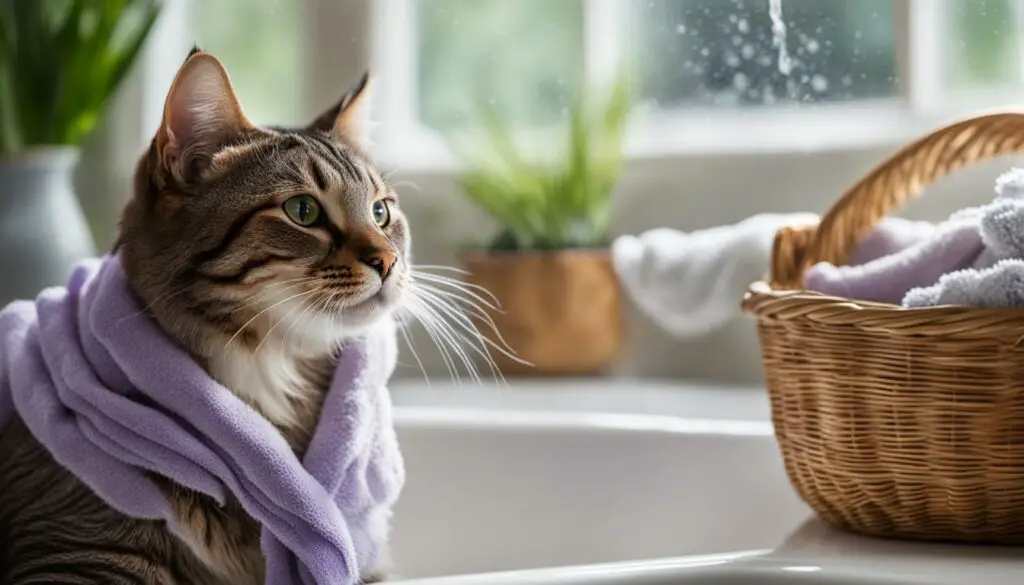
The Benefits of Regular Cat Bathing
Cat bathing is an essential aspect of their overall hygiene and well-being. Regular bathing provides numerous benefits to cats, including maintaining a healthy coat, reducing dandruff, eliminating parasites, controlling odors, and minimizing shedding. Additionally, bathing allows owners to closely observe their cat’s skin condition and detect any abnormalities that may require further attention.
Regular cat bathing is particularly beneficial for long-haired cats as it helps prevent matting and tangles. Bathing also provides an opportunity for owners to bond with their cats and create a positive grooming experience. By establishing a bathing routine, cats can become more comfortable with the process over time.
| Benefits of Regular Cat Bathing | Key Points |
|---|---|
| Maintains a healthy coat | Regular bathing helps remove dirt, oils, and dead hair from the coat, keeping it clean and healthy. |
| Reduces dandruff | Regular bathing can help reduce dry, flaky skin and minimize dandruff in cats. |
| Eliminates parasites | Bathing helps remove fleas, ticks, and other parasites that may be present on a cat’s coat. |
| Controls odors | Regular bathing helps eliminate unpleasant odors that can develop on a cat’s coat over time. |
| Minimizes shedding | Bathing can help reduce excessive shedding by removing loose hair from the coat. |
It is important to note that while regular bathing is beneficial, it is essential not to overdo it. Cats have natural oils on their skin that help keep it moisturized, and excessive bathing can strip these oils, leading to dryness and irritation. The frequency of cat bathing should be based on the individual needs of the cat and their coat type. Consulting with a veterinarian can provide guidance on establishing an appropriate bathing schedule.
The Risks of Bathing Cats Too Frequently
Bathing cats is an essential part of their grooming routine, but it’s important to be mindful of how often you bathe your feline friend. While regular bathing has its benefits, such as maintaining a healthy coat and reducing shedding, overbathing can have negative effects on your cat’s skin and overall well-being.
When cats are bathed too frequently, their skin’s natural oils can be stripped away, leading to dryness, irritation, and an imbalance in pH levels. This can result in discomfort for your cat and may even exacerbate existing skin conditions. It’s crucial to find the right balance and frequency of bathing that works for your cat’s individual needs and coat type.
Consulting with your veterinarian is the best way to determine the appropriate bathing schedule for your cat. They can evaluate your cat’s skin condition, consider any existing skin issues or allergies, and provide personalized recommendations. By following their guidance, you can ensure that you’re not bathing your cat too frequently and risking any potential skin problems.
The Risks of Overbathing
Overbathing cats can lead to the following issues:
- Dry, itchy skin: Stripping away the natural oils can leave your cat’s skin dry, leading to discomfort and itchiness.
- Skin irritation: Frequent bathing can irritate your cat’s sensitive skin, causing redness, inflammation, and even sores.
- Imbalance in pH levels: Cats have a specific pH balance on their skin, and overbathing can disrupt this balance, making them more susceptible to skin issues.
- Stress and anxiety: Cats generally dislike being immersed in water, so frequent baths can lead to increased stress and anxiety, which can negatively impact their overall well-being.
By being mindful of the risks associated with overbathing, you can ensure that your cat’s grooming routine promotes their health and happiness. Remember to consult with your veterinarian, maintain a suitable bathing schedule, and use cat-specific grooming products to keep your cat looking and feeling their best.
| Risks of Bathing Cats Too Frequently | Prevention Measures |
|---|---|
| Dry, itchy skin | Follow recommended bathing frequency |
| Skin irritation | Use cat-specific grooming products |
| Imbalance in pH levels | Consult with a veterinarian for personalized advice |
| Stress and anxiety | Create a calm and positive bathing environment |
Expert Tips for Cat Bathing Success
When it comes to bathing cats, it’s important to approach the process with patience and care. Here are some expert tips to help make cat bathing a positive experience:
- Introduce your cat to water gradually and positively: Start by letting your cat get comfortable with the sound and sight of running water before attempting a full bath. Gradually introduce them to water by using a damp cloth or sponge to gently wipe their fur.
- Use treat rewards to associate bathing with positive experiences: Reward your cat with treats and praise throughout the bathing process to create positive associations. This helps make bath time a more enjoyable and less stressful experience for your feline friend.
- Minimize loud sounds and distractions: Cats are sensitive to loud noises, so try to minimize any loud sounds or distractions during the bathing process. This helps create a calm and soothing environment, making it easier for your cat to relax.
- Take breaks if your cat becomes anxious or stressed: Pay attention to your cat’s body language and behavior during the bath. If they become anxious or stressed, take a break and allow them some time to calm down before continuing.
- Seek professional grooming services if necessary: If your cat consistently becomes too stressed or aggressive during baths, it may be worthwhile to consider professional grooming services. Groomers have experience in handling cats and can help ensure a safe and stress-free bathing experience for your feline companion.
- Maintain regular grooming and hygiene routines between baths: While baths are important for maintaining a cat’s hygiene, regular grooming between baths is equally important. Brush your cat’s fur regularly to remove loose hair and prevent matting. Additionally, regularly clean their ears and trim their nails to keep them clean and healthy.
- Monitor your cat’s skin and coat condition: After each bath, take the time to monitor your cat’s skin and coat condition. Look for any changes, abnormalities, or signs of irritation. This allows you to address any potential issues early on and seek veterinary care if necessary.
Remember, every cat is unique, and their tolerance for bathing may vary. It’s important to be patient and adapt to your cat’s individual needs and preferences. With time, practice, and positive reinforcement, bathing can become a more enjoyable experience for both you and your feline companion.
Table: Cat Bathing Supplies Checklist
| Item | Purpose |
|---|---|
| Cat shampoo | Specifically formulated for cats, maintaining their skin health and pH balance. |
| Gentle pet-friendly brush | To remove loose hair and prevent matting. |
| Cotton balls | To protect the ears from water during the bath. |
| Non-skid rubber mat or towel | To provide stability and prevent slipping in the sink or tub. |
| Large towels | To dry your cat after the bath. |
| Treats | For positive reinforcement and rewards during and after the bath. |
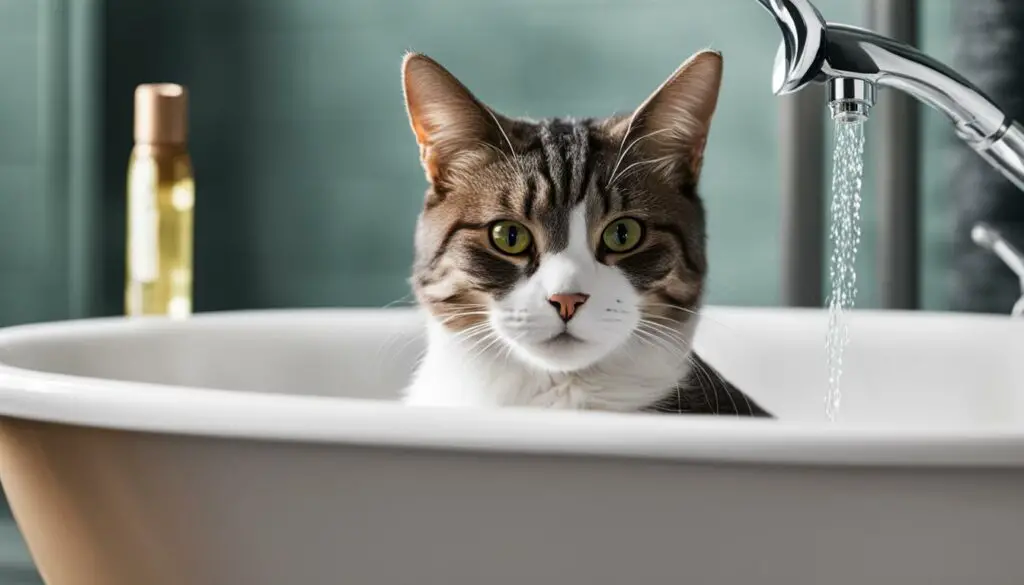
Safe Alternatives to Human Shampoo for Cats
When it comes to bathing your cat, using human shampoo is not recommended. The pH levels and ingredients in human shampoo can be harmful to cats and may cause skin issues or even toxicity. So, what are the safe alternatives to human shampoo for cats? Let’s explore some options.
1. Cat-specific shampoos: There are numerous shampoos specifically formulated for cats available in the market. These shampoos are designed to maintain the natural pH balance of a cat’s skin and contain ingredients that are safe for feline use. Look for shampoos that are mild, hypoallergenic, and free from harsh chemicals or fragrances.
2. Natural or organic shampoos: If you prefer natural products for your cat, there are natural or organic shampoos available as well. These shampoos often use gentle, plant-based ingredients that are safe for cats and can help maintain their skin health without any harsh chemicals.
3. Medicated shampoos: In case your cat has specific skin conditions or requires medicated treatment, there are medicated shampoos available that are safe for feline use. These shampoos are formulated to address specific skin issues and should be used under the guidance of a veterinarian.
Table: Comparison of Safe Shampoo Alternatives for Cats
| Shampoo Type | Key Features | Recommended Brands |
|---|---|---|
| Cat-specific shampoos | Maintains natural pH balance, hypoallergenic | Brand A, Brand B, Brand C |
| Natural or organic shampoos | Gentle, plant-based ingredients, no harsh chemicals | Brand X, Brand Y, Brand Z |
| Medicated shampoos | Addresses specific skin issues, requires veterinary guidance | Brand P, Brand Q, Brand R |
Choosing the right shampoo for your cat depends on their individual needs and any existing skin conditions. It is always a good idea to consult with your veterinarian to recommend a suitable shampoo that caters to your cat’s specific requirements. Remember, using safe alternatives to human shampoo ensures the well-being and health of your feline friend during bath time.
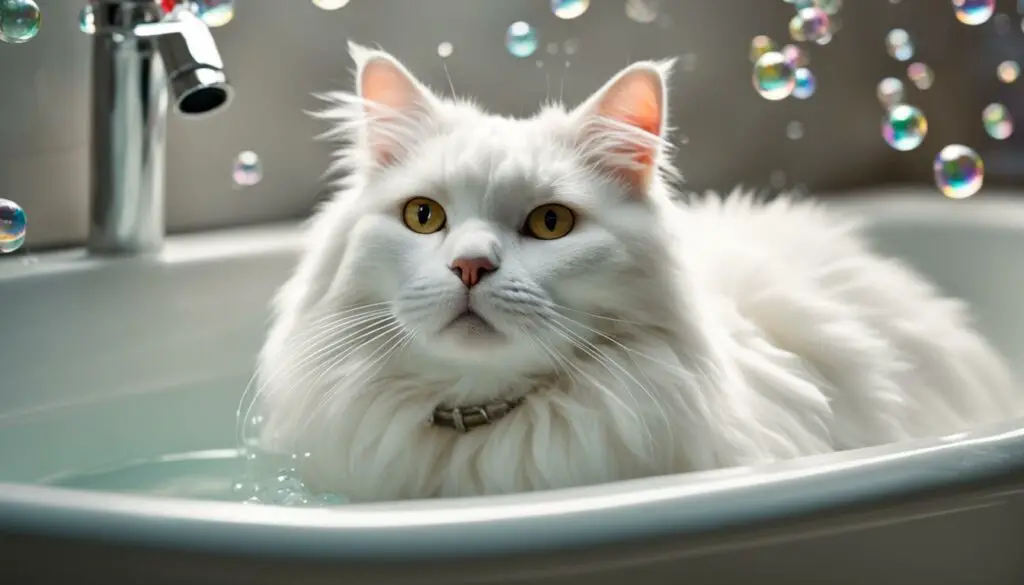
Conclusion
After exploring the facts, it is clear that using human shampoo on cats is not recommended. The differences in pH levels and potential harmful ingredients can disrupt a cat’s skin health and overall well-being. It is crucial to use safe shampoo specifically formulated for cats to maintain their natural balance and prevent any potential harm.
Regular cat bathing, with the appropriate products, offers several benefits to a cat’s coat, skin, and overall hygiene. It helps keep their coat clean, reduce dandruff, eliminate parasites, control odors, and minimize shedding. Long-haired cats can greatly benefit from regular bathing to prevent matting and tangles.
When choosing a shampoo for your cat, opt for products that are designed for feline use, mild, hypoallergenic, and free from harsh chemicals or fragrances. It is always a good idea to consult with your veterinarian to recommend a suitable shampoo for your cat’s specific needs and any existing skin conditions.
Maintaining proper cat hygiene is crucial for their overall health and well-being. Alongside regular bathing, it is important to maintain regular grooming and hygiene routines between baths. Monitor your cat’s skin and coat condition for any changes or abnormalities and seek professional grooming services if necessary. By following these guidelines, you can ensure that your cat stays clean, healthy, and happy.
FAQ
Can I use human shampoo on my cat?
It is not recommended to use human shampoo on cats due to differences in pH levels and potential harmful ingredients. Using cat-specific shampoos and grooming products is essential for maintaining a cat’s skin health, pH balance, and overall hygiene.
Why is cat hygiene important?
Maintaining proper hygiene is crucial for cats’ overall health and well-being. Regular bathing helps to keep their coat clean, reduce dandruff, eliminate parasites, and remove dead hair. It also helps control odors and reduces shedding, especially for long-haired cats.
What are the risks of using human shampoo on cats?
Human shampoos often contain different ingredients and pH levels than those formulated for cats. Using human shampoo on cats can disrupt the natural balance of their skin’s pH, leading to skin irritation, dryness, and other skin issues. Additionally, some ingredients in human shampoos may be toxic to cats if ingested or absorbed through the skin.
How do I choose a safe shampoo for my cat?
When selecting a shampoo for your cat, opt for products that are specifically formulated for feline use. Look for shampoos that are mild, hypoallergenic, and free from harsh chemicals or fragrances. It is also a good idea to consult with your veterinarian to recommend a suitable shampoo for your cat’s specific needs.
How should I prepare for a cat bath?
Before bathing your cat, trim their nails to avoid scratches, brush their coat to remove any dead skin and hair, and place a non-skid rubber mat or towel in the sink or tub to prevent slipping. Have all necessary grooming products, such as cat shampoo, towels, and treats, within reach to ensure a smooth bathing experience.
What is the bathing process for cats?
Fill the bath with warm (not hot) water, gently lower your cat into it, and use a small jug to pour water over their body. Dilute cat shampoo with water before applying it to minimize the risk of skin irritation. If needed, use a wet washcloth to clean their face. Rinse thoroughly, towel dry, and ensure your cat is fully dry before allowing them to go outside.
How can I calm a nervous cat during bath time?
Cats can be nervous during bath time, so it is essential to create a calm and positive environment. Offer treats as positive reinforcement, provide reassurance through gentle petting and soothing words, and consider seeking professional grooming services if your cat becomes too stressed or aggressive.
How should I dry and care for my cat after a bath?
Gently wrap your cat in a large towel and pat them dry. Towel drying is usually preferred, but you can use a blow dryer on the lowest setting if your cat is comfortable with it. Ensure your cat is fully dry before allowing them to go outside, and offer treats and praise to reinforce positive behavior.
What are the benefits of regular cat bathing?
Regular cat bathing offers several benefits, including maintaining a healthy coat, reducing dandruff, removing dead hair and parasites, controlling odors, and minimizing shedding. It also provides an opportunity to observe any skin issues or abnormalities that may require further attention.
What are the risks of bathing cats too frequently?
Overbathing can strip a cat’s skin of natural oils, leading to dryness, irritation, and an imbalance in their skin’s pH. The frequency of cat bathing should be based on their individual needs and coat type. Consult with your veterinarian to determine the appropriate bathing schedule for your cat.
What are some expert tips for successful cat bathing?
Introduce your cat to water gradually and positively, use treat rewards to associate bathing with positive experiences, minimize loud sounds and distractions, take breaks if your cat becomes anxious or stressed, and maintain regular grooming and hygiene routines between baths. Monitor your cat’s skin and coat condition for any changes or abnormalities.
What are safe alternatives to human shampoo for cats?
Instead of using human shampoo on cats, opt for safe alternatives specifically formulated for feline use. There are various cat shampoo options available, including hypoallergenic, natural, and medicated shampoos. Consult with your veterinarian to find the most suitable shampoo for your cat’s specific needs and any existing skin conditions.
Source Links
- https://www.purina.co.uk/articles/cats/health/daily-care/do-cats-need-baths
- https://vcahospitals.com/know-your-pet/personal-care-products-and-your-pet
- https://www.purina-arabia.com/articles/cats/health/daily-care/do-cats-need-baths

